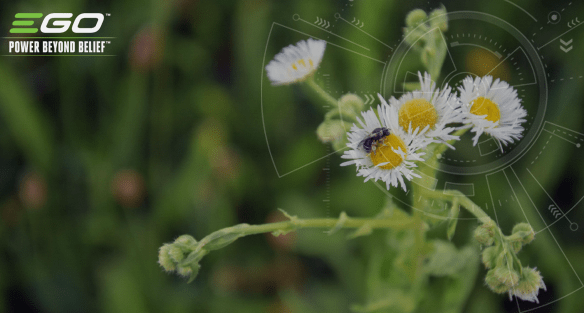Insects are a keystone of our ecosystem - they pollinate, feed other animals and break down organic matter.
A recent UK study called Bugs Matter has revealed that flying insect populations have been more than decimated - some areas have lost 65% in the last 18 years. The study cites agricultural practices as a key offender - pesticides, insecticides and monoculture - plus loss of habitat, pollution and air pollution.
While changes need to be made at a national and international level, at home, we can make small but significant changes to our gardens and ways of gardening that help to support our flying bugs.
1. Mow your lawn less frequently
We’re known for our battery operated lawn mowers but we’re also happy to advise our customers to use them less often. Doing this will allow diversity to flourish in your lawn, including types of grasses and other plants that attract and sustain insect life.
Many people are able to create a compromise. For example, you might:
- Decide to mow your lawn once every two weeks instead of every week
- Leave dedicated areas to grow tall for the insects
- Mow pathways through your home-grown meadow.
Long grass
Areas of long grass are essential to insects like bees, butterflies, moths, and craneflies:
- Shelter
- Breeding
- Food
Long grass also provides habitats for other wildlife like spiders, toads and mice, some of whom rely on insects for food, and seed for birds.
Check out our guide on eco-friendly lawn care for green gardeners too.
2. Install plants that insects love
Insects have their favourite plants, just as we do. The ideal is to cultivate more diversity in your garden:
- Seeding (or allowing natural seeding) of different types of grasses in your lawns, like Meadow Foxtail and False Oat.
- Planting (or allowing) many types of flowering shrubs, plants and wildflowers, like buddleia, lavender, honeysuckle, marigolds, and forget-me-nots.
- Create a herb garden insects, love flowering chives, dill and others - convenient for your kitchen too!
Weeds
As the bees and other insects wake up and get busy in the spring, nature provides a host of plants that flower quickly, which they can feast on while other plants are still waking up.
We think of dandelions, daisies and buttercups as inconvenient, but if you want to help insect life along in the sunny, cool weeks of spring, leave a few weeds on your lawn and in your borders.
3. Avoid chemical pesticides and insecticides
Sadly, the government is again allowing the use of harmful pesticides that “damage the nervous systems and navigational abilities of bees and other pollinators”, despite damning evidence.
As well as harming our insects, pesticides can seep into waterways and affect fish, frogs and other aquatic life. And these chemicals don’t break down quickly - they linger in the soil and water for a long time.
If you’ve got a genuine pest problem, you might find a natural remedy works:
- Companion planting, where some species can rub shoulders and keep each other’s insect pests at bay.
- Organic, home-made sprays and dressings that deter or get rid of bad pest problems - made from ingredients like garlic, catmint and neem oil.
4. Create a compost heap
Many different types of insects, including the flying kind, thrive in or close to compost heaps. Some of them assist the process of decay.
We created a thorough guide on how to build a compost heap, so you might want to head over there if you’re interested.
5. Build an insect log pile hotel
Dead and decaying wood is of great value to a woodland or garden. Living shrubs and trees can provide shelter, breeding grounds and food for insects for decades. In death, they release nutrients into the ground and provide food for nature’s recyclers - the detritivores.
In woodlands, dead wood is sometimes left where it falls or even left standing. Alternatively, it might be cut up with a chain saw and stacked - which is probably a more realistic approach for a garden.
A stack of logs can also create a natural bug hotel that’s more robust and less obvious than those you can buy in shops.
Closely stack in a slight hollow in the soil, with cracks and gaps filled with other garden detritus like leaves and small hedge trimmings. Your log pile will quickly be populated by insects looking for a home where they can thrive.
Interested in more green gardening tips?
